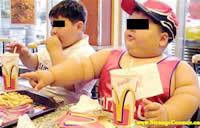
It's what we do.
tips
| |
| News |
| Frugal or Free |
| This Month's Topic |
| Food |
| Pet Pages |
| Columns |
| LifeTools |
| Religion |
| Keeping it Together |
| Special Needs |
| TV and Movie Reviews |
| Restaurant Reviews |
| Homeslice |
| Fun Activities |
| Blank |
| Caution, shopping at Walmart may cause weight gain~ |
|
Walmart is so well known for having the lowest prices in the country. Have you ever shopped there and just wondered how in the heck they can sell a widget so cheap? Besides their common practice of buying junky stuff from overseas, it now appears that Walmart's cheapo food has become a problem. According to the NY Times:
The reason, as the New York Times article explains, has to do with the Farm Bill, which heavily subsidizes soybeans, corn, and wheat - three major ingredients, or sources, of many of the ingredients in junk food. The result? According to Andrea Dickension on WiseBread.com, the real price of fruits and vegetables between 1985 and 2000 increased by nearly 40 percent while the real price of soft drinks (aka liquid corn in the form of corn syrup) declined by 23 percent. The reason the least healthful calories in the supermarket are the cheapest is that those are the ones the farm bill encourages farmers to grow. So even foods that are more processed, that require more labor to produce, cost less. The article goes on to explain the origins of the Farm Bill and the detrimental, albeit unintended, effect it is having on our population. The farm bill helps determine what sort of food your children will have for lunch in school tomorrow. The school-lunch program began at a time when the public-health problem of America’s children was undernourishment, so feeding surplus agricultural commodities to kids seemed like a win-win strategy. Today the problem is overnutrition, but a school lunch lady trying to prepare healthful fresh food is apt to get dinged by U.S.D.A. inspectors for failing to serve enough calories; if she dishes up a lunch that includes chicken nuggets and Tater Tots, however, the inspector smiles and the reimbursements flow. The farm bill essentially treats our children as a human Disposall for all the unhealthful calories that the farm bill has encouraged American farmers to overproduce. It ends on a hopeful note, claiming that the resurgence in organic farming and local produce, combined with consumer demands and the American ideal of a free market economy, may give us a chance to reclaim our farming heritage and our health. I'm not sure that I'm so optimistic about our chances for revamping what seems like extremely complicated and pork-filled legislation.
|
 Therapy dogs Frankie and Chloe visit kids and the elderly. Full story Therapy dogs Frankie and Chloe visit kids and the elderly. Full story Chow time!- With the cat food recall bringing so much media attention, it's a good time to study the methods commonly used to prepare commercial cat and dog food...what you don't know COULD hurt your pet. Full story...
|
| Back to Food main page |
|---|
Grocery Shopping Online
Like free things?! We do too...
CA PC Protection Bundle Single User 2007/ IBM ViaVoice Standard
$79.82, free after 2 rebates, at Tiger Direct. See more deals that we found just like this one!
.ChoicePoint® ADAM Program
Opt to have your company receive faxed
alerts about missing children in your area.

